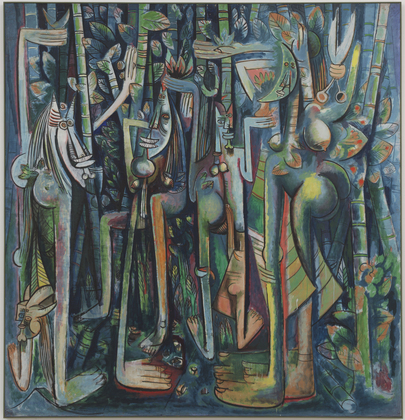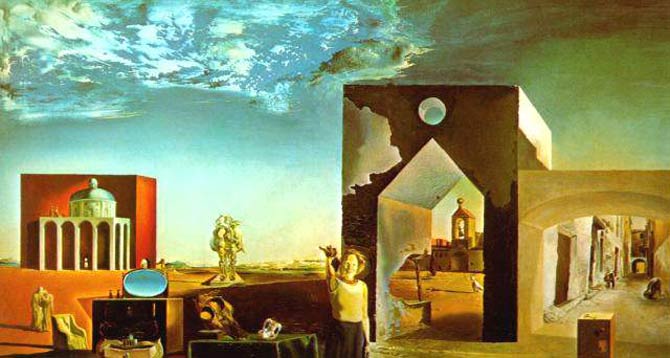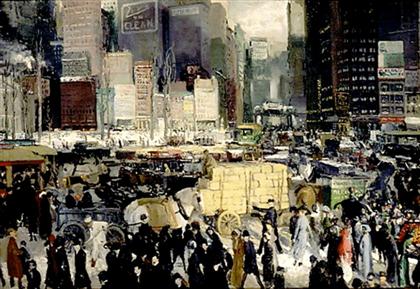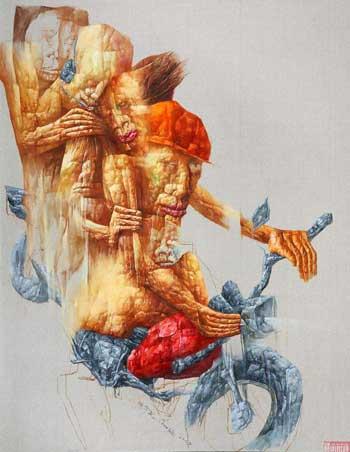Use of Primitivism in Various Art Movements

The painting created by Wilfredo Lam, one of the famous representatives of Modern Primitivism, represents the image of primitive way of life and depiction of early beliefs of Afro-Cubans. The author himself was born in Cuba but spent certain period of his life in Europe mastering new European art tendencies, Surrealism, in particular. The impact of surrealistic European art is clearly observed in the painting including such of its characteristic features as the depiction of fantastic elements. The Jungle can be described as the living picture of a spiritual life of Afro-Cubans. The images shown in the work are drawn using the ancient tradition of art and the primitive depiction of nature.
The primitive is represented as the antithesis of modernity (Sweeney, 2004). The belonging of Wilfredo Lam’s The Jungle to Primitivism is proved by the artistic techniques used by the author. Broadly speaking, Primitivism is the depiction of the surrounding world in accordance with the elements of visual arts of the primitive societies. The composition of the painting can be described as the image of primitive Afro-Cuban people life, people’s belief in the woman-horse, one of the central figures in the Afro-Cuban mythology.
The artistic techniques used by Lam include the reductive depiction of human bodies and natural subjects. The faces are pictured as crescent-shaped as they were traditionally imaged by ancient artists, and the bodies are hypertrophied in size. Besides, the simplification of the real world is clearly observed in the images of plants. It should be emphasized that people and plants are presented as the interconnected elements, the technique commonly applied in the primitive world.
Exploration of Freud’s psychoanalytic theories

Suburbs of a Paranoiac-Critical Town: Afternoon on the Outskirts of European History is the painting created by Salvador Dali, which represents one of the bright examples of the surrealistic art movement in the beginning of 20th century. The composition encompasses the image of city. Gala, Salvador Dali’s wife and his source of inspiration, is the central figure depicted on the painting. There are a lot of objects imaged on the painting but all of them are represented in the surrealistic vision of the world. As in the majority of surrealistic works the artist aims to draw our attention to certain objects. In this way he gives us a way to see the symbolic meaning of the work itself as well as to abstract our minds from the real world.
The art of Salvador Dali was influenced by the works on psychoanalysis of Sigmund Freud to the large extent. As one of the major inspirers of the surrealistic movement Dali contributed certain specific features to Surrealism. In particular, his passion for psychology, dreams interpretation, and the understanding of the psychological background of people actions led him to the exploration of Freud’s psychoanalytic theories.
Inspired by the Freud’s ideas on consciousness and sub-consciousness, Dali firmly believed in that life as a whole is determined by the unconscious actions of people. The painting shows us the unreal vision of the town. It is represented like the image of town in a dream. The unusual presentation of the painting objects proves the surrealistic view of the artist, his unconscious vision of the reality.
The changing role of art and the influence of mass culture

The prints of Marilyn Monroe were created by Andy Warhol in the middle of the XX century, when the popularity of mass culture raised significantly. The commercialization of art became one of the main tendencies in the world art in that period. The prints shown above are the bright examples of the influence of popular culture on visual arts, which reoriented the aim of art from its primary purpose of self-expression to the pursuit of commercial benefits. Marilyn Monroe is a symbolic figure of the American pop culture of the XX century. It is not surprisingly that her images were widely used with the commercial purposes.
Andy Warhol was the designer of some of the famous mass culture products in the 50s and 60s of XX century. The popularization of art at that time gave the opportunity for people to gain from popular culture. The rapid development of innovations and significant rise of business activity affected the attitude of people to art as well. It became the object of making money. Unlike most avant-garde and fine artists, workers in the mass arts rarely enjoy total freedom to create personally expressive art (Chapman, 2003).
However, despite the lack of meaningfulness, which popular culture introduced to art, its artifacts are worthy to study. Andy Warhol essentially combined some simple artist techniques with the needs of the market. He made the prints more colorful and eye-catching and that brought the attention of the public to them. People liked Marilyn Monroe, because they imagined her as a symbol of American girl. Her images were in demand and Warhol created the art product for mass production.
A new form of realism in response to political and social events occurring in the early 20th century

The paintings of George Bellows, the prominent figure in the American visual arts of the early XX century, were focused on the depiction of the American reality at that time. The artists contributed a lot in the formation of a new form of realism, later called American realism. New York, 1911 is the image of the big industrial city and the rapidness of its everyday life. American realism was appealed to depict the accelerating pace of time, bustle of the city streets and to express the feeling of the city life.
As we can see the composition is concentrated on the chaos and bustle of the New York City of 1911. The painting gives us the feeling of the pressure of the downtown on the masses. Ostensibly, they were engrossed by such requirements of the big city life as being always occupied and not wasting time as well as living per organizer. George Bellows presented us the image of American life of that time but it can be said that new forms of realism in the world and the depiction of the reality in other capitalistic countries derived from the United States. Nowadays we can observe the lifestyle of the American cities in other parts of the world.
However, American realism contributed a lot to the development of the American visual arts. The painting of George Bellows reflects the characteristic features of this art movement, including using of dark and subdued colors and tones. The light plays a crucial role in the painting with a more clear accentuation of the objects with shadows and penumbras.
An evaluation of the impact of these themes on the art of the latter half the 20th century and into the 21st

The formation and development of the Contemporary art was based on the rethinking of the Modernism postulates. Starting from the After War period, the rapid changes in the social, economic and political spheres resulted in the transformations in the world art. Postmodernism began to develop at that time and it became the source of formation of the Contemporary art movements of the late XX and XIX centuries. The painting shown above represents a bright example of new tendencies.
In the making of the Contemporary art the philosophical ideas gradually transferred from the modernists views on the exclusiveness of New Time to the acceptance of the vast diversity existing in the modern world. This is a crucial idea, because the ambiguity and diversity of thoughts are the pillars of the XIX century art.
However, it should be acknowledged that these ideas arose from the thoughts of the Modern epoch including the ideas of Sigmund Freud, surrealists’ movement, consumerism and others.
Butler (2002) cites the statements of Susan Sontag and Ihab Hassan, art critics,
They argued that the work of postmodernists was deliberately less unified, less obviously ‘masterful’, more playful or anarchic, more concerned with the processes of our understanding than with the pleasures of artistic finish or unity, less inclined to hold a narrative together, and certainly more resistant to a certain interpretation, than much of the art that had preceded it.
In conclusion, the formation of the Contemporary art is definitely based upon the ideas of earlier art movements. It can be said that postmodern derived from the modern ideas introducing more ambiguity, avant-garde, and the vast pluralism, which is undoubtedly is one of its predominant features.
References
Butler, C. (2002). Postmodernism: a very short introduction. Oxford, the United Kingdom: Oxford University Press.
Chapman, L.H. (2003). Studies of mass arts. Studies in Arts Education, 44(3), n.pag. Web.
Exhibit of “21st Century Visual Art Document Exhibition”. (n.d.). Web.
Marilyn Monroe Prints. (n.d.). Web.
Sweeney, T. (2004). From fetish to subject: race, modernism, and primitivism, 1919-1935. Westport, CT, USA: Praeger.
Suburbs of a Paranoiac-Critical Town: Afternoon on the Outskirts of European History. (n.d.). Web.
The Jungle. (n.d.). Web.